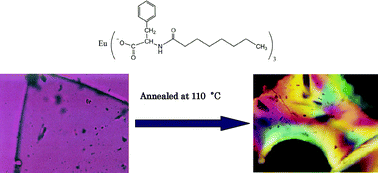Aggregation in methanol and formation of molecular glasses for europium(iii) N-acylaminocarboxylates: effects of alkyl chain length and head group†
Abstract
Europium(III) complexes of N-acyl-DL-alaninates (

* Corresponding authors
a
Department of Chemistry, Nara Women's University, Kita-uoya-nishi-machi, Nara, Japan
E-mail:
iida@cc.nara-wu.ac.jp
Fax: +81 7422 03397
Tel: +81 7422 03397
b Department of Textile and Apparel Science, Nara Women's University, Nara, Japan
c Department of Physics, Nara Women's University, Nara, Japan
d Division of Chemistry, Hokkaido University, Sapporo, Japan
Europium(III) complexes of N-acyl-DL-alaninates (

 Please wait while we load your content...
Something went wrong. Try again?
Please wait while we load your content...
Something went wrong. Try again?
G. Naren, A. Yasuda, M. Iida, M. Harada, T. Suzuki and M. Kato, Dalton Trans., 2009, 5512 DOI: 10.1039/B820169B
To request permission to reproduce material from this article, please go to the Copyright Clearance Center request page.
If you are an author contributing to an RSC publication, you do not need to request permission provided correct acknowledgement is given.
If you are the author of this article, you do not need to request permission to reproduce figures and diagrams provided correct acknowledgement is given. If you want to reproduce the whole article in a third-party publication (excluding your thesis/dissertation for which permission is not required) please go to the Copyright Clearance Center request page.
Read more about how to correctly acknowledge RSC content.
 Fetching data from CrossRef.
Fetching data from CrossRef.
This may take some time to load.
Loading related content
